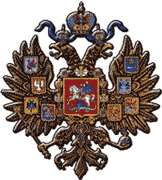 |
|
 |
Webmaster's Notes |
 |
Geographical and Person Names |
 |
Nobility Titles |
 |
Transliteration |
 |
Family Names |
Author's Notes
There are quite many people interested in the Romanov imperial family and some of them would like to learn more about the Romanov family history and the genealogy of the Romanovs, too. Indeed, there has been a kind of "Romanov boom" during the last ten - fifteen years. And who Actually, the boom started with the novell of Robert Massie (it cannot be called a biography, even less a historical monography, as all the citations are totally missing - we don't know whom he's citing and where). So, who were all those Grand Dukes and Duchesses, whom did they marry, how are the Romanovs of the past connected with the ruling noble houses of Europe of today? This website is trying to offer some help in these questions.
True, there are some large royalty databases available on the net. These are, however, somewhat impractical and sometimes slow to browse. And, as for the Romanovs, but for very few, none of them is focused exclusively on the Romanov Family. This is why the webmaster took up the effort to put together a Romanov genealogical database which would be easy to use and browse and which would contain as much essential genealogical information as possible.
The core of the website is naturally the collection of the genealogical records. These records will also include pedigree charts and ancestral tables, which I hope will give a more visual idea of the genealogical connections and make the browsing easier. Hopefully they will illustrate the more or less complex connections between the noble houses of Europe and give information for those interested in the question of the Russian Imperial succession - to which question the webmaster won't take any stand whatsoever (although he has his own opinion :) ).
The pattern of the genealogical records is the family group sheet system. This style of presenting the records is perhaps more laborious than other possible patterns but it gives quite a lot of information about single persons in a convenient way.
It should be especially pointed out that, in order to avoid any possible misunderstandings, the Gregorian dates are used in the records, except when the sources are unclear and do not reveal whether a Julian or a Gregorian date is in question. In several records both dates are included (OS = Old Style, NS = New Style).
Only short biographical notes have been included in the records - the records are genealogical tables, not biographies. Likewise, so far there are very few pictures included in the records, too. There are enough Romanov photo galleries on the web already, some of them excellent, some a little bit naïve.
The webmaster will be grateful for all feedback, especially if somebody can provide him with additional information (dates, birth & death places etc.). Any corrections, no matter in how small details, are welcome, too.
Geographical and Person Names
In the genealogical tables most geographical names appear in their original form: 'Milano' instead of 'Milan', 'Moskva' instead of 'Moscow'. The same principle has been applied to the person names: If Emperor Nikolai II called himself 'Nikolai' in his mother tongue, that is the way the name will be printed in the ancestral tables, too (See Transliteration). Certainly, some general concessions have been made, especially with the German-British families where the original use of the names is more than often not quite clear.
Nobility Titles
As for the titles of the nobility, especially the title "Prince" always gives us some headache. As we know, in German there are two kinds of princes: "Fürst" and "Prinz", and the Russian title "Knjaz" (Князь) or "Velikij Knjaz" (Великий Князь) means exactly the German "Fürst" or "Großfürst" - there were no "real" Princes (German "Prinz") - that is, sons of the head of a noble house, in Russia. Both German and Russian titles are mostly translated as "Princes" or "Grand Princes/Grand Dukes" in English. To avoid any misunderstandings, all "Princes" will be called just "Princes" in the tables and charts, no matter what kind of princes they are or were.
The title "Tsarina" is often wrongly used to denote the Tsar's spouse. There was never a "Tsarina" or "Czarina" in Russia. The correct title is and remains "Tsaritsa", (Царица) which was commonly used, although the official title was "Imperatritsa" (Императрица), Empress. For the female Romanovs before Petr I The Great the correct form "Tsaritsa" will be used. The daughters of all Tsars and Emperors were usually called Grand Duchesses, not Tsarevnas. Actually, we only know one "real" Tsarevna: Sofia the Regent. The title "Tsarevich/Czarevich" (or, highly officially, "Tsesarevich/Czesarevich", Цесаревич), on the other hand, was commonly in use till 1917.
Another common mistake in public genealogies is the translation of the Emperor's official title "Imperator i Samoderzhitel vseja Rusi" (Император И Самодержитель Всея Руси). "Rus" (Русь) is the old appellation for "Russia" (the genitive Руси/Rusi). Thus, the correct translation is "Emperor and Autocrat of All Russia".
Until the Ukaz ("Order") of Emperor Aleksandr III (1866), there seemed to be all too many Grand Dukes and Grand Duchesses in Russia - and that's what the Emperor, too, was thinking. In his Ukaz he then ordered that only the direct sons and the direct grandsons of an Emperor/Empress could be called "Grand Dukes/Duchesses". The great-grandchildren of the Emperor were merely "Princes" (Russian "Knjaz", князь). In the name indices all these Grand Dukes and Duchesses may look all alike. We therefore take the liberty to add the words "of Russia" to denote the children of the rulers (a common practice in many other Romanov genealogies), although this never was an official title. Thus, "Konstantin Pavlovich, Grand Duke of Russia" indicates that this very Grand Duke was a son of an Emperor.
